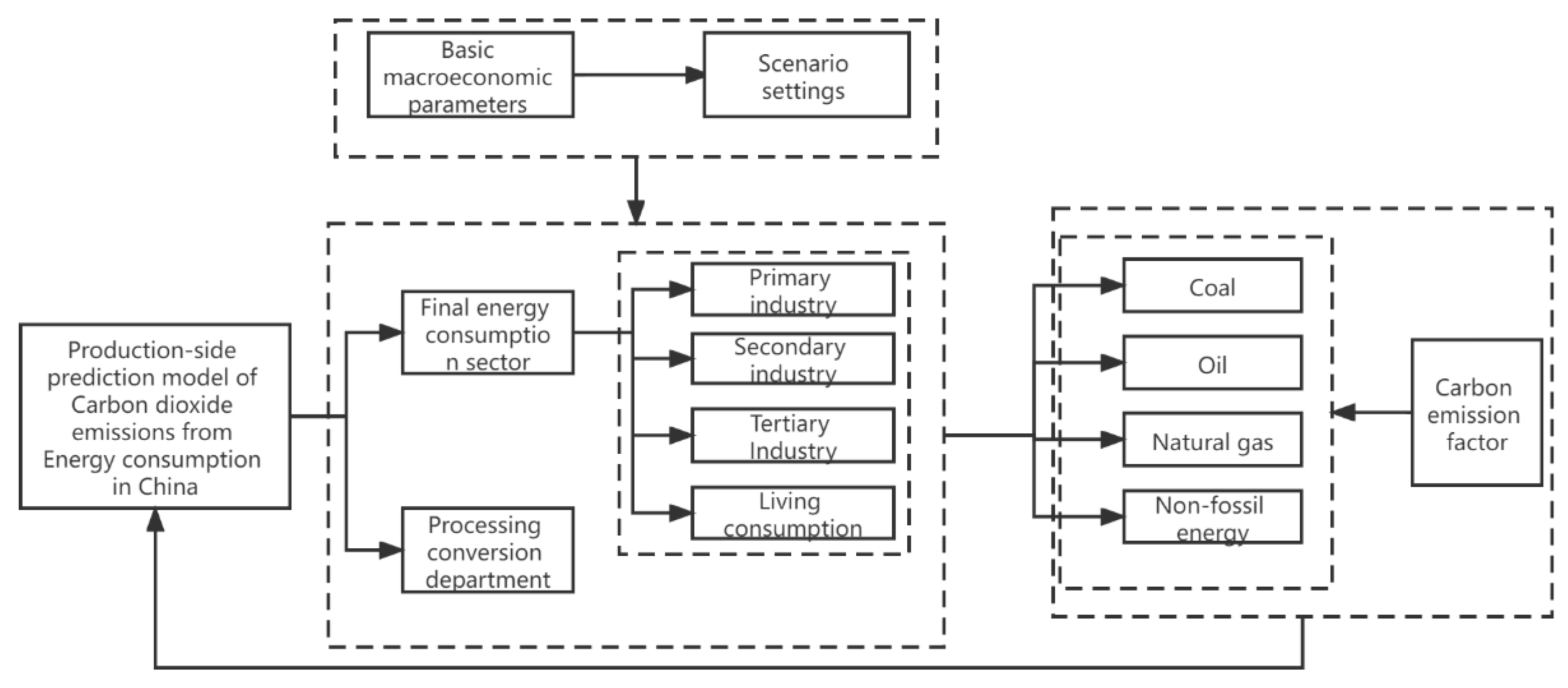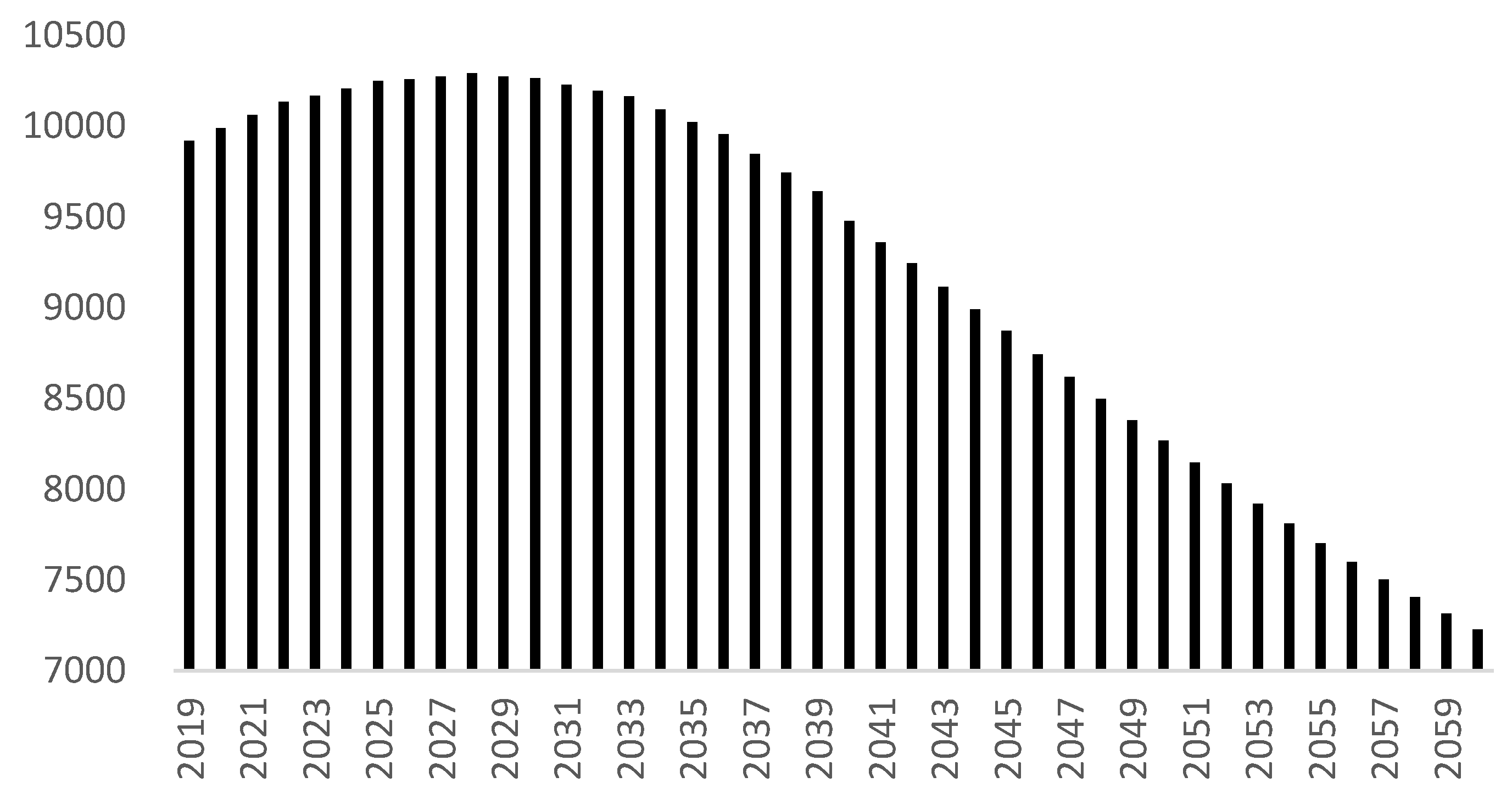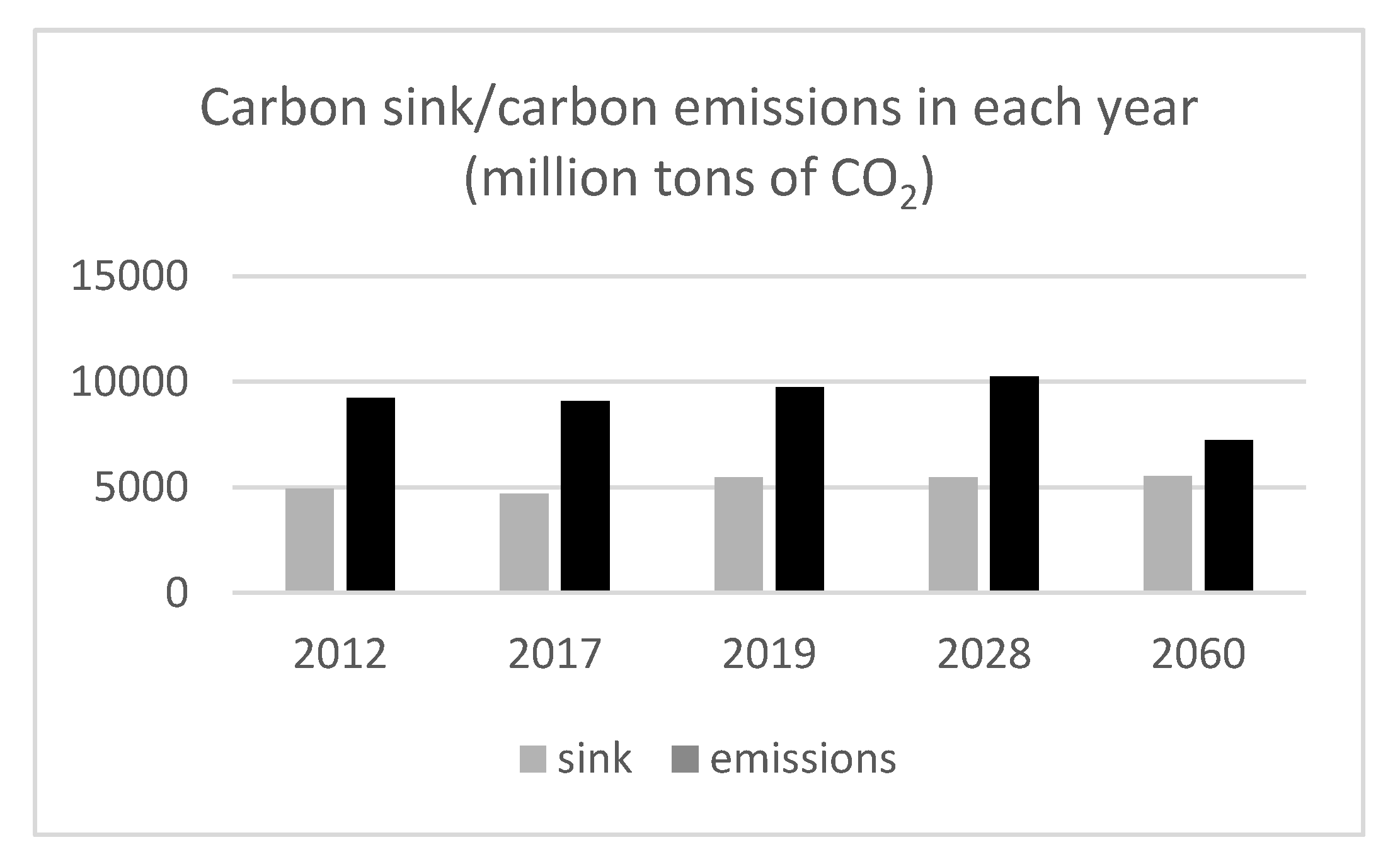Accounting for China’s Net Carbon Emissions and Research on the Realization Path of Carbon Neutralization Based on Ecosystem Carbon Sinks
Abstract
1. Introduction
2. Literature Review
2.1. Literature on Carbon Neutralization
2.2. Literature on Carbon Emission Calculation
2.3. Literature on Carbon Sink Calculation
3. Materials and Methods
3.1. Carbon Emissions Accounting and Forecasting
3.1.1. Accounting for CO2
3.1.2. LEAP Model Setting
3.1.3. Scenario Setting
3.2. Carbon Sink Measurement
3.3. Carbon Sink Projections
3.4. Data Source
4. Results and Discussion
4.1. Carbon Emission Results and Projections
4.2. Carbon Sink Results and Projections
4.3. Carbon Gap
5. Conclusions
Author Contributions
Funding
Institutional Review Board Statement
Informed Consent Statement
Data Availability Statement
Conflicts of Interest
References
- Yang, Y.; Shi, Y.; Sun, W.; Chang, J.; Zhu, J.; Chen, L.; Wang, X.; Guo, Y.; Zhang, H.; Yu, L.; et al. Terrestrial carbon sinks in China and around the world and their contribution to carbon neutrality. Sci. China Life Sci. 2022, 65, 861–895. [Google Scholar] [CrossRef] [PubMed]
- Vandenbergh, M. The Carbon-Neutral Individual; New York University School of Law: New York, NY, USA, 2007. [Google Scholar]
- Zhang, Y.; Linlin, X.; Weining, X. Analyzing Spatial Patterns of Urban Carbon Metabolism: A Case Study in Beijing, China. Landsc. Urban Plan. 2014, 130, 184–200. [Google Scholar] [CrossRef]
- Liu, L.; Wang, Y.; Wang, Z.; Li, S.; Li, J.; He, G.; Li, Y.; Liu, Y.; Piao, S.; Gao, Z.; et al. Potential contributions of wind and solar power to China’s carbon neutrality. Resour. Conserv. Recycl. 2022, 180, 106155. [Google Scholar] [CrossRef]
- Li, X.; Tan, X.; Wu, R.; Xu, H.; Zhong, Z.; Li, Y.; Zheng, C.; Wang, R.; Qiao, Y. Paths for Carbon Peak and Carbon Neutrality in Transport Sector in China. Chin. J. Eng. Sci. 2021, 23. Available online: https://kns.cnki.net/kcms/detail/11.4421.G3.20211213.1514.011.html (accessed on 22 September 2022). [CrossRef]
- Jia, X.; Zhang, Z.; Wang, F.; Li, Z.; Wang, Y.; Aviso, K.B.; Foo, D.Y.C.; Nair, P.N.S.B.; Tan, R.R.; Wang, F. Regional carbon drawdown with enhanced weathering of non-hazardous industrial wastes. Resour. Conserv. Recycl. 2022, 176, 105910. [Google Scholar] [CrossRef]
- Li, K.; Shen, S.; Fan, J.-L.; Xu, M.; Zhang, X. The role of carbon capture, utilization and storage in realizing China’s carbon neutrality: A source-sink matching analysis for existing coal-fired power plants. Resour. Conserv. Recycl. 2022, 178, 106070. [Google Scholar] [CrossRef]
- Li, F.; Gu, Z. Opportunities, Paths and Values for the High-Quality Development of China’s Cultural Industry from the Perspective of “Dual Carbon”. J. Shanghai Norm. Univ. Philos. Soc. Sci. 2021, 50, 79–87. [Google Scholar]
- Li, Z.; Zhang, D.; Pan, L. Low-Carbon Transition of China’s Energy Sector and Suggestions with ‘Carbon-Peak and Carbon-Neutrality’ Target. J. Chin. Soc. Power Eng. 2021, 41, 905–909+971. [Google Scholar]
- Qi, Y.; Cai, Q. Innovation in urban governance in the context of carbon neutrality. Gov. Stud. 2021, 37, 88–98. [Google Scholar]
- De La Peña, L.; Guo, R.; Cao, X.; Ni, X.; Zhang, W. Accelerating the energy transition to achieve carbon neutrality. Resour. Conserv. Recycl. 2022, 177, 105957. [Google Scholar] [CrossRef]
- Hu, J.; Yang, Y.; Lu, S. Carbon Neutrality Models and Their Ecological Cost in Carbon Deficit Provinces: The Case of Liaoning Province. Econ. Geogr. 2021, 41, 193–200. [Google Scholar]
- Zhou, W.; Zhuang, G. Zero-carbon city construction pathways of Xiongan New Area. China population. Resour. Environ. 2021, 31, 122–134. [Google Scholar]
- Zhang, W.; Huang, B.; Luo, D. Effects of land use and transportation on carbon sources and carbon sinks: A case study in Shenzhen, China. Landsc. Urban Plan. 2014, 122, 175–185. [Google Scholar] [CrossRef]
- Liu, K. Research on China’s 2060 Carbon Neutrality Commitment and Its Implementation Paths. Ecol. Econ. 2021, 37, 13–17, 39. [Google Scholar]
- Song, X.; Song, X.; Zhang, J. Research and Suggestions on Regional Carbon Neutralization Pathways. Nat. Resour. Econ. China 2021. Available online: https://kns.cnki.net/kcms/detail/11.5172.f.20211206.1549.001.html (accessed on 22 September 2022).
- Huang, X.-J.; Zhang, X.-Y.; Lu, X.-H.; Wang, P.-Y.; Qin, J.-Y.; Jiang, Y.-C.; Liu, Z.-M.; Wang, Z.; Zhu, A.-X. Land development and utilization for carbon neutralization. J. Nat. Resour. 2021, 36, 2995–3006. [Google Scholar] [CrossRef]
- Yu, B.; Zhao, G.; An, R.; Chen, J.; Tan, J.; Li, X. Research on China’s CO2 Emission Pathway under Carbon Neutral Target. J. Beijing Inst. Technol. Soc. Sci. Ed. 2021, 23, 17–24. [Google Scholar]
- Chen, J.; Gao, M.; Cheng, S.; Hou, W.; Song, M.; Liu, X.; Liu, Y.; Shan, Y. County-level CO2 emissions and sequestration in China during 1997–2017. Sci. Data 2020, 7, 1–12. [Google Scholar] [CrossRef]
- Wu, J.; Xu, J. Carbon emission deduction model and application base on production function theory. J. Jiangsu Univ. Nat. Sci. Ed. 2019, 40, 320–324. [Google Scholar]
- Magee, C.L.; Devezas, T.C. Specifying Technology and Rebound in the IPAT Identity. Procedia Manuf. 2018, 21, 476–485. [Google Scholar] [CrossRef]
- Du, Q.; Chen, Q.; Lu, N. Forecast of China’s carbon emissions based on modified IPAT model. Acta Sci. Circumstantiae 2012, 32, 2294–2302. [Google Scholar]
- Duan, X.; Wang, X.; Lu, F.; Ouyang, Z. Carbon sequestration and its potential by wetland ecosystems in China. Acta Ecol. Sin. 2008, 28, 463–469. [Google Scholar]
- Fang, J.; Guo, Z.; Pu, S.; Chen, A. Estimation of carbon sinks in terrestrial vegetation in China from 1981 to 2000. Sci. Sin. Terrae 2007, 6, 804–812. [Google Scholar]
- Hu, J.; Wang, Q. An Quantitative Study of Ecological Compensation in Ethnic Minority Areas Based on Carbon Balance. Guangxi Ethn. Stud. 2019, 06, 145–154. [Google Scholar]
- Ma, M.; Li, Q.; Zhou, W. The Study of Carbon Ecological Compensation in Yellow River Basin Based on Carbon Neutrality. Yellow River 2021, 1–7. Available online: https://kns.cnki.net/kcms/detail/41.1128.tv.20210630.1114.002.html (accessed on 22 September 2022).
- Wan, L.; Lin, C.; Chen, Y. Temporal and Spatial Patterns of Interprovincial Carbon Compensation in China Based on Relative Carbon Deficit. Resour. Environ. Yangtze Basin 2020, 29, 2572–2583. [Google Scholar]
- Li, L.; Dong, J.; Xu, L.; Zhang, J. Spatial variation of land use carbon budget and carbon compensation zoning in functional areas: A case study of Wuhan Urban Agglomeration. J. Nat. Resour. 2019, 34, 1003–1015. [Google Scholar]
- Tao, B.; Ge, Q.; Li, K.; Shao, X. Progress in the studies on Carbon Cycle in terrestrial ecosystem. Geogr. Res. 2002, 16, 151–166. [Google Scholar]
- Lu, Y.; Cai, F. The Impact of Demographic Change on Potential Growth Rate: A Comparison of China and Japan. J. World Econ. 2014, 37, 3–29. [Google Scholar]
- Cao, J.; Tao, Q. Calculation and analysis of agricultural carbon compensation in the Yangtze River Economic Belt. J. Agric. Resour. Environ. 2021, 1–10. Available online: https://kns.cnki.net/kcms/detail/12.1437.S.20210311.1641.001.html (accessed on 22 September 2022).
- Han, Z.; Meng, L.; Xu, J.; Wu, Y.; Zhou, Z. Temporal and Spatial Difference in Carbon Footprint of Regional Farmland Ecosystem --Taking Jiangsu Province as a Case. J. Agro-Environ. Sci. 2012, 31, 1034–1041. [Google Scholar]
- Yang, L.; Tang, L. Analysis and Prediction of Carbon Balance on Quzhou County. China Popul. Resour. Environ. 2013, 23, 10–13. [Google Scholar]
- Zhou, J.; Wang, Y.; Liu, X.; Shi, X.; Cai, C. Spatial Temporal Differences of Carbon Emissions and Carbon Compensation in China Based on Land Use Change. Sci. Geogr. Sin. 2019, 39, 1955–1961. [Google Scholar]
- Zhu, X.; Wang, Z. Spatial Correlation Pattern and Influencing Factors of Carbon Footprint Breadth in China. World Surv. Res. 2021, 38–48. [Google Scholar]
- Wang, Z.; Guo, Z.; Song, K.; Liu, D.; Zhang, B.; Zhang, S.; Li, F.; Jin, C.; Yang, T.; Huang, N. Effects of Land Use/Cover Change on Net Primary Productivity of Sanjiang Plain, During 2000–2005. J. Nat. Resour. 2009, 24, 136–146. [Google Scholar]
- Zhang, L.; Ren, X.; Wang, J.; He, H.; Wang, S.; Wang, M.; Piao, S.; Yan, H.; Ju, W.; Gu, F.; et al. Interannual Variability of Terrestrial Net Ecosystem Productivity over China: Regional Contributions and Climate Attribution. Environ. Res. Lett. 2019, 14, 014003. [Google Scholar] [CrossRef]
- Ming, C.; Bo, T.; Ke, L.; Xue, S.; Prience, S.D. Interannual Variation in Terrestrial Ecosystem Carbon Fluxes in China from 1981 to 1998. Acta Bot. Sin. 2003, 45, 552–560. [Google Scholar]
- Xie, H.; Chen, X.; Lin, K.; Hu, A. The Ecological Footprint Analysis of Fossil Energy and Electricity. Acta Ecol. Sin. 2008, 4, 1729–1735. [Google Scholar]
- Yang, G.; Shang, P.; He, L.; Zhang, Y.; Wang, Y.; Zhang, F.; Zhu, L.; Wang, Y. Interregional carbon compensation cost forecast and priority index calculation based on the theoretical carbon deficit: China as a case. Sci. Total Environ. 2019, 654, 15. [Google Scholar] [CrossRef]
- Han, G.-X.; Li, J.-Y.; Qu, W.-D. Effects of nitrogen input on carbon cycle and carbon budget in a coastal salt marsh. Chin. J. Plant Ecol. 2021, 45, 321–333. [Google Scholar] [CrossRef]
- Xie, W.; Chen, S.; Hu, Z. Factors Influencing the Variability in Soil Heterotrophic Respiration from Terrestrial Ecosystem in China. Environ. Sci. 2014, 35, 334–340. [Google Scholar]
- Wang, F.; Tang, J.; Ye, S.; Liu, J. Blue Carbon Sink Function of Chinese Coastal Wetlands and Carbon Neutrality Strategy. Bull. Chin. Acad. Sci. 2021, 36, 241–251. [Google Scholar]
- Zhang, M.; Huang, X.; Chuai, X.; Xie, X.; Zhu, Z.; Wang, Y. Spatial Distribution and Changing Trends of Net Ecosystem Productivity in China. Geogr. Geo-Inf. Sci. 2020, 36, 69–74. [Google Scholar]
- Zhang, J.; Zhang, A.; Dong, J. Carbon Emission Effect of Land Use and Influencing Factors Decomposition of Carbon Emission in Wuhan Urban Agglomeration. Resour. Environ. Yangtze Basin 2014, 23, 595–602. [Google Scholar]
- Li, J.; Zhang, Y.; Gu, F.; Huang, W.; Guo, R.; Hao, W.; Xia, X. Temporospatial variations in net ecosystem productivity in Northeast China since 1961. Acta Ecol. Sin. 2014, 34, 1490–1502. [Google Scholar]
- Yuan, Y.; Zhao, T.; Wang, W.; Chen, S.; Wu, F. Projection of the Spatially Explicit Land Use/Cover Changes in China, 2010–2100. Adv. Meteorol. 2013, 2013, 1–9. [Google Scholar] [CrossRef]
- Cao, Q.-W.; Gu, C.-L.; Guan, W.-H. China’s urbanization SD modelling and simulation based on land use. J. Nat. Resour. 2021, 36, 1062–1084. [Google Scholar] [CrossRef]
- Liu, X.; Liang, X.; Li, X.; Xu, X.; Ou, J.; Chen, Y.; Li, S.; Wang, S.; Pei, F. A future land use simulation model (FLUS) for simulating multiple land use scenarios by coupling human and natural effects. Landsc. Urban Plan. 2017, 168, 94–116. [Google Scholar] [CrossRef]
- Liu, W.; Jiang, W.; Tang, Z.; Han, M. Pathways topeakcarbon emissions inChina by2030: Ananalysis inrelation totheeconomic growth rate. Sci. China Earth Sci. 2022, 65, 1057–1072. [Google Scholar] [CrossRef]
- Yang, J. Research on the development and innovation of the policy of increasing and reducing the linkage between urban and rural construction land in China. Hebeinongji 2021, 11, 123–124. [Google Scholar]



| Meaning | 2019 | 2030 | 2060 |
|---|---|---|---|
| GDP growth rate/% | 6 | 3.92 | 2.0 |
| Percentage of primary industry/% | 7.5 | 6 | 3 |
| Percentage of secondary industry/% | 38.77 | 32 | 23 |
| Tertiary industry share/% | 53.77 | 62 | 78 |
| Population size/million people | 1410.08 | 1442 | 1393.4 |
| Urbanization rate/% | 62.71 | 70 | 85 |
| Share of clean energy generation/% | 32.7 | 42.4 | 65 |
| Primary industry energy intensity | 265.19 | 224.6 | 161.1 |
| Energy intensity of secondary industry | 1802.67 | 1218.2 | 768 |
| Tertiary sector energy intensity | 359.189 | 304.2 | 218.3 |
| Urban energy consumption per capita/ | 0.31 | 0.34 | 0.40 |
| Rural energy consumption per capita | 0.30 | 0.27 | 0.20 |
| Coefficient Name | Specific Values |
|---|---|
| Forest | 3.81 t C/hm2·a |
| Garden | 2.38 t C/hm2·a |
| Eastern lakes wetlands | 0.57 t C/hm2·a |
| Yunnan and Guizhou Lakes wetlands | 0.20 t C/hm2·a 2 |
| Northeast Lakes Wetlands | 0.04 t C/hm2·a |
| Heterotrophic respiration in agricultural soils | 5.26 t C/hm2·a |
| Grassland | 0.95 t C/hm2·a |
| Coastal and offshore wetlands | 1.73 t C/hm2·a |
| Mengxin Lake wetland | 0.30 t C/hm2·a |
| Qinghai-Tibet Lake wetland | 0.13 t C/hm2·a |
| Swampy wetlands | 0.52 t C/hm2·a |
| Crop | Carbon Absorption Rate | Water Content | Economic Factor |
|---|---|---|---|
| Rice | 0.4144 | 0.12 | 0.45 |
| Wheat | 0.4835 | 0.12 | 0.4 |
| Corn | 0.4709 | 0.13 | 0.4 |
| Sorghum | 0.45 | 0.13 | 0.35 |
| Grain | 0.45 | 0.12 | 0.4 |
| Potatoes | 0.4226 | 0.7 | 0.7 |
| Beans | 0.45 | 0.13 | 0.34 |
| Cotton | 0.45 | 0.08 | 0.1 |
| Canola | 0.45 | 0.1 | 0.25 |
| Vegetables | 0.45 | 0.9 | 0.6 |
| Peanuts | 0.45 | 0.1 | 0.43 |
| Melon | 0.45 | 0.9 | 0.7 |
| Tobacco | 0.45 | 0.12 | 0.55 |
| Other | 0.45 | 0.12 | 0.4 |
| WOODLAND | GRASSLAND | GARDEN | ARABLE LAND | WETLANDS | |
|---|---|---|---|---|---|
| 2060 | 28,806.10 | 26,699.02 | 2023.41 | 12,924.92 | 5460.85 1 |
| 2028 | 28,510.97 | 26,514.51 | 2018.72 | 12,820.87 | 5460.67 1 |
| 2019 | 28,412.59 | 26,453.01 | 2017.16 | 12,786.19 | 5404.64 1 |
| 2017 | 25,280.19 | 21,932.03 | 2117.44 | 13,488.12 | 5360.26 1 |
| 2012 | 25,339.7 | 21,956.5 | 2016.7 | 13,515.8 | 3848.55 1 |
| WOODLAND | GRASSLAND | GARDEN | WETLANDS | ARABLE LAND | |
|---|---|---|---|---|---|
| 2060 | 109,751.24 | 25,364.07 | 4815.72 | 3154.48 | 7813.51 |
| 2030 | 108,626.78 | 25,188.78 | 4804.55 | 3166.25 | 7750.61 |
| 2019 | 108,251.97 | 25,130.36 | 4800.84 | 3170.17 | 7729.65 |
| 2017 | 96,317.52 | 20,835.43 | 3382.98 | 3574.28 | 9037.46 |
| 2012 | 96,544.26 | 20,858.68 | 4799.76 | 2800.72 | 9373.10 |
| WOODLAND | GRASSLAND | GARDEN | WETLANDS | ARABLE LAND | |
|---|---|---|---|---|---|
| 2060 | 72.71% | 16.81% | 3.19% | 2.10% | 5.18% |
| 2030 | 71.99% | 16.69% | 3.18% | 2.10% | 5.14% |
| 2019 | 71.74% | 16.65% | 3.18% | 2.10% | 5.12% |
| 2017 | 63.83% | 13.81% | 2.24% | 2.37% | 5.99% |
| 2012 | 63.98% | 13.82% | 3.18% | 1.86% | 6.21% |
| WOODLAND | GRASSLAND | GARDEN | WETLANDS | ARABLE LAND | |
|---|---|---|---|---|---|
| 2060 | 1.04% | 0.7% | 0.23% | −0.37% | 0.81% |
| 2030 | 0.35% | 0.23% | 0.08% | −0.12% | 0.27% |
| 2019 | 12.40% | 20.61% | 41.91% | −11.30% | −14.47% |
| 2017 | −0.23% | −0.11% | −29.52% | 27.62% | −3.58% |
| 2012 | 1.04% | 0.7% | 0.23% | −0.37% | 0.81% |
| TOTAL CARBON SINK | TOTAL CARBON EMISSIONS | NET EMISSIONS | ANNUAL VARIATION | CARBON SINKS/ CARBON EMISSIONS | |
|---|---|---|---|---|---|
| 2060 | 5534.75 | 7226.70 | 1691.95 | −3.21% | 76.59% |
| 2030 | 5484.37 | 10,262.10 | 4777.73 | 1.28% | 53.44% |
| 2019 | 5466.37 | 9753.59 | 4287.22 | −1.13% | 56.04% |
| 2017 | 4711.15 | 9097.27 | 4386.12 | 0.41% | 51.79% |
| 2012 | 4927.14 | 9224.31 | 4297.17 | - | 53.41% |
Publisher’s Note: MDPI stays neutral with regard to jurisdictional claims in published maps and institutional affiliations. |
© 2022 by the authors. Licensee MDPI, Basel, Switzerland. This article is an open access article distributed under the terms and conditions of the Creative Commons Attribution (CC BY) license (https://creativecommons.org/licenses/by/4.0/).
Share and Cite
Wang, N.; Zhao, Y.; Song, T.; Zou, X.; Wang, E.; Du, S. Accounting for China’s Net Carbon Emissions and Research on the Realization Path of Carbon Neutralization Based on Ecosystem Carbon Sinks. Sustainability 2022, 14, 14750. https://doi.org/10.3390/su142214750
Wang N, Zhao Y, Song T, Zou X, Wang E, Du S. Accounting for China’s Net Carbon Emissions and Research on the Realization Path of Carbon Neutralization Based on Ecosystem Carbon Sinks. Sustainability. 2022; 14(22):14750. https://doi.org/10.3390/su142214750
Chicago/Turabian StyleWang, Nuo, Yuxiang Zhao, Tao Song, Xinling Zou, Erdan Wang, and Shuai Du. 2022. "Accounting for China’s Net Carbon Emissions and Research on the Realization Path of Carbon Neutralization Based on Ecosystem Carbon Sinks" Sustainability 14, no. 22: 14750. https://doi.org/10.3390/su142214750
APA StyleWang, N., Zhao, Y., Song, T., Zou, X., Wang, E., & Du, S. (2022). Accounting for China’s Net Carbon Emissions and Research on the Realization Path of Carbon Neutralization Based on Ecosystem Carbon Sinks. Sustainability, 14(22), 14750. https://doi.org/10.3390/su142214750






